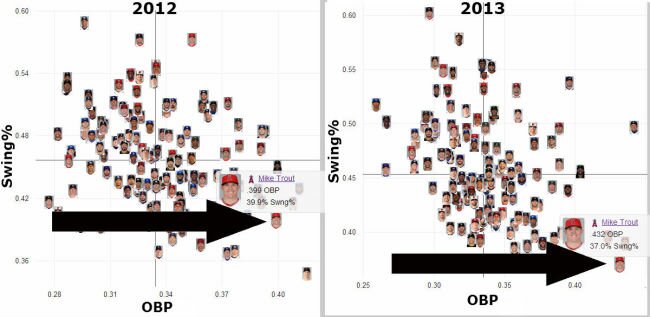A Patient Trout is a Better Trout
 Alec Dopp |
Alec Dopp |  Thursday, December 26, 2013 at 9:00AM
Thursday, December 26, 2013 at 9:00AM
Mike Trout has become best known for several things during his brief tenure in the major leagues, including (but not limited to) the following: Plus bat speed, which has enabled him to hit for a high average and produce screaming line-drive home runs with consistency, and above-average baserunning and defense, which has empowered him to nab bases at a ridiculously high rate and play eye-opening defense in center field. Both of these dexterities have been on display in his first two full seasons, holding true to a .324/.416/.560 slash line, 87.2% stolen base rate and 1.4 defensive WAR rating, according to Baseball Reference. But like just about every professional player, Trout has his deficiencies.
Well, had his deficiencies.
The one knock on Trout coming into his sophomore 2013 campaign -- and it wasn't really a "knock," to be honest -- was his plate discipline. While each of his offensive attributes were considered elite by scouting standards, this aspect of his game was only average at best. Trout struck out at a 21.8% clip as a rookie, which was higher than the league-average mark of 18.1% two seasons ago, and didn't draw too many walks, shown by a 10.5% walk rate that was only slightly above the 8.1% average rate. This left many wondering if a 'sophomore slump' would ensue in 2013 as advanced scouting reports of his game become available.
Boy do those people feel silly.

All Trout did last season was trim his strikeout rate by 2.8% and increase his walk rate to 15.4% -- the highest mark of any qualified right-handed batter in baseball. Sure, his batting average and slugging percentage decreased by inconsequential marks and he stole fewer bases, but his on-base percentage skyrocketed to .432 last season (third-best in baseball behind Miguel Cabrera (.442) and Joey Votto (.435)), and that was the driving force behind his elevated offensive value last season compared to his rookie campaign.
How was he able to get on base more frequently? Let's take a look.
Improved Eye at the Plate
 Only 69.3% of Trout's 2012 hacks were on strikes, compared to 71% in 2013. The league average since 2012 is 67.7%.
Only 69.3% of Trout's 2012 hacks were on strikes, compared to 71% in 2013. The league average since 2012 is 67.7%.
Along with lowering his chase rate to 20.8% last season (compared to 24.3% in 2012), Trout pulled the trigger less frequently than any other qualified batter in baseball last season, evidenced by a 37.0% swing rate. This puts him in company with some of the most disiplined hitters in the league, including Marco Scutaro (whose 16.9% chase rate was the lowest of any qualified batter in 2013) and Joe Mauer (whose 35.9% swing rate since 2012 is the lowest in baseball).Yes, Trout was slightly less reluctant to offer at non-strikes than those two, but his improvements in that respect last season give reasons to believe he will become even more disciplined in the years to come.
Efficient with his swings

On top of pulling the trigger less frequently (37.0%) than any other qualified batter last season, Trout posted baseball's third-highest on-base percentrage (.432), as previously noted. But why are these two metrics noteworthy? As we see from the graph to the right, Trout -- along with Votto's 38.9% swing rate and .435 OBP -- was essentially the most efficient hitter in baseball last season at getting on base while still hacking less frequently than any other batter. Cabrera posted a league-best .442 OBP last season, but offered at 49.7% of all offerings thrown to him. Thus, Trout was much more efficient at finding ways to get on base than Cabrera, which shows he employs a more refined offensive approach.
Working the count
But improved plate discipline and swing efficiency only go so far. Perhaps the most relevant factor behind Trout's OBP rise stems from the increase in pitches seen per plate appearance.

It's important to establish right off the bat that Trout saw more pitches per plate appearance on average last season (4.21, which was sixth-best among qualified batters) than in 2012 (4.08). So, clearly, Trout has become more patient at the dish with time. As it turns out, this increase contributed to his increase in on-base percentage, shown by the graph above. While Trout's OBP in plate appearances lasting either one or two pitches last season were lower than two seasons ago, his OBP from pitch three and beyond were significantly higher, and continue to increase with each pitch. Interestingly enough, Trout's .454 OBP in plate appearances lasting three or more pitches was the highest mark among any qualified batter last season (along with a .316 BA, which was tops in the league, as well).
What we're learning is that when Trout goes deeper into counts (i.e. three or more pitches into a plate appearance), he is a much more effective hitter in that he gets on base at a rate no other professional batter can. Knowing this, opposing pitchers will likley try to get ahead of him early in the count by throwing over the plate -- which could also spell for disaster, as Trout boasts a .702 slugging percentage (third-best in baseball last season) in plate appearances lasting three or less pitches.
It seems opposing managers will have to pick their posion against Trout, especially when he comes to the plate. Do you try to pound the edge of the zone and go deep into counts against him and run the risk of him getting on base at a league-best rate, or do you throw over the plate early and thus leave open the possibility of him battering your pitcher with extra-base hits?
Either way, you're in trouble.


